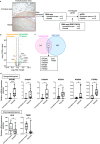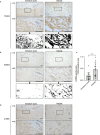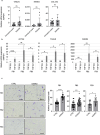Exclusive expression of KANK4 promotes myofibroblast mobility in keloid tissues
- PMID: 38622256
- PMCID: PMC11018845
- DOI: 10.1038/s41598-024-59293-z
Exclusive expression of KANK4 promotes myofibroblast mobility in keloid tissues
Abstract
Keloids are characterized by abnormal wound healing with excessive accumulation of extracellular matrix. Myofibroblasts are the primary contributor to extracellular matrix secretion, playing an essential role in the wound healing process. However, the differences between myofibroblasts involved in keloid formation and normal wound healing remain unclear. To identify the specific characteristics of keloid myofibroblasts, we initially assessed the expression levels of well-established myofibroblast markers, α-smooth muscle actin (α-SMA) and transgelin (TAGLN), in scar and keloid tissues (n = 63 and 51, respectively). Although myofibroblasts were present in significant quantities in keloids and immature scars, they were absent in mature scars. Next, we conducted RNA sequencing using myofibroblast-rich areas from keloids and immature scars to investigate the difference in RNA expression profiles among myofibroblasts. Among significantly upregulated 112 genes, KN motif and ankyrin repeat domains 4 (KANK4) was identified as a specifically upregulated gene in keloids. Immunohistochemical analysis showed that KANK4 protein was expressed in myofibroblasts in keloid tissues; however, it was not expressed in any myofibroblasts in immature scar tissues. Overexpression of KANK4 enhanced cell mobility in keloid myofibroblasts. Our results suggest that the KANK4-mediated increase in myofibroblast mobility contributes to keloid pathogenesis.
© 2024. The Author(s).
Conflict of interest statement
The authors declare no competing interests.
Figures




References
-
- Alibert, J.-L.-M. Descriptions des maladies de la peau observées a l'Hôpital Saint-Louis, et exposition des meilleures méthodes suivies pour leur traitement. Paris: Barrois l’ainé. vol. 2 (1806).
MeSH terms
Grants and funding
LinkOut - more resources
Full Text Sources
Molecular Biology Databases
Research Materials
Miscellaneous

